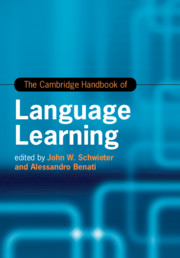Book contents
- The Cambridge Handbook of Language Learning
- Cambridge Handbooks in Language and Linguistics
- The Cambridge Handbook of Language Learning
- Copyright page
- Contents
- Figures
- Tables
- Contributors
- Acknowledgements
- Introduction
- Part I Theories
- Part II Methods
- Part III Skill Development
- Part IV Individual Differences
- Part V Pedagogical Interventions and Approaches
- Part VI Context and Environment
- 27 Bilingual Education and Policy
- 28 Heritage Language Instruction
- 29 Minority Languages at Home and Abroad: Education and Acculturation
- 30 Study Abroad and Immersion
- 31 Teacher Education: Past, Present, and Future
- Part VII Moving Forward
- Index
- References
28 - Heritage Language Instruction
from Part VI - Context and Environment
Published online by Cambridge University Press: 25 June 2019
- The Cambridge Handbook of Language Learning
- Cambridge Handbooks in Language and Linguistics
- The Cambridge Handbook of Language Learning
- Copyright page
- Contents
- Figures
- Tables
- Contributors
- Acknowledgements
- Introduction
- Part I Theories
- Part II Methods
- Part III Skill Development
- Part IV Individual Differences
- Part V Pedagogical Interventions and Approaches
- Part VI Context and Environment
- 27 Bilingual Education and Policy
- 28 Heritage Language Instruction
- 29 Minority Languages at Home and Abroad: Education and Acculturation
- 30 Study Abroad and Immersion
- 31 Teacher Education: Past, Present, and Future
- Part VII Moving Forward
- Index
- References
Summary
The concept of a heritage language is broad and highly dependent on context, making it impossible to offer a generalizable account in a chapter such as this. Instead, we present specific contexts to illustrate the concept, focusing principally on the United States but also including other contexts with which we are familiar. The term heritage language emerged in Canada in the late 1970s in the context of the Ontario Heritage Languages Programs (Cummins, 2005). It was used to refer to any language other than English and French, the country’s two official languages, and included languages spoken by Canada’s First Nation people or by its immigrants (Cummins, 1991). In the Australian context, heritage languages were defined as languages other than English (also known as LOTEs; Clyne, 1991). In the United States, the term has been used synonymously with community language, native language, and mother tongue to refer to an immigrant, indigenous, or ancestral language that a speaker has a personal relevance and desire to (re)connect with (Wiley, 2005).
- Type
- Chapter
- Information
- The Cambridge Handbook of Language Learning , pp. 673 - 695Publisher: Cambridge University PressPrint publication year: 2019

